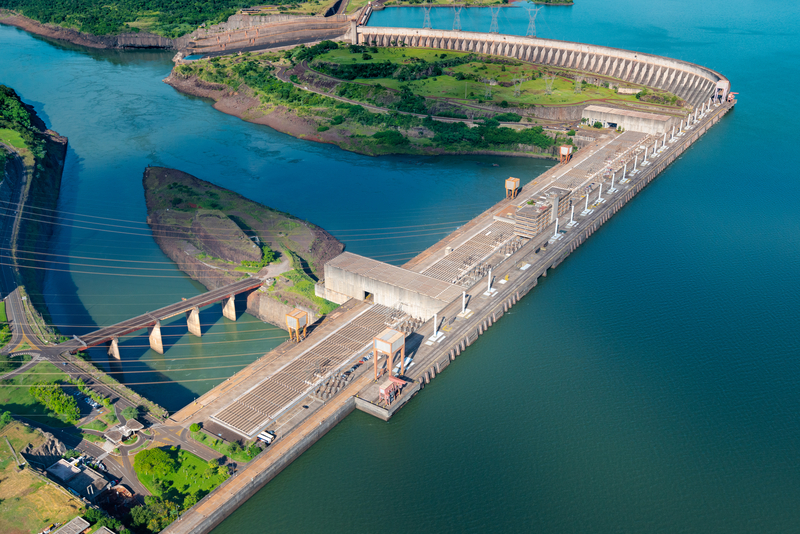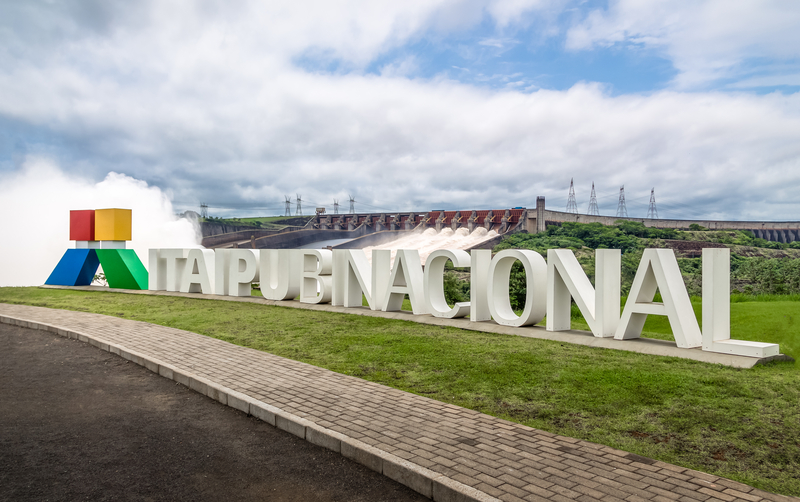Last updated on November 26th, 2022
The Itaipu Dam is the pride of South America. It is one of the most impressive structures in the region, with a scale unmatched by any other civil engineering project. It is also among the most productive power plants in the world, showing what is possible with intelligent design and strategic positioning. Two nations had to set aside their differences to make it happen. Now they are reaping the fruits of their sacrifice and hard work. Read on to learn about the journey and discover 50 interesting facts about the Itaipu Dam.
The Itaipu Dam at a Glance
1. What’s in a Name?
“Itaipu” comes from the name of an island near the dam. In the Guarani language, the word means “the stone that dreams and sings” or “the sounding stone.”
2. Claim to Fame
The Itaipu Dam is the second-largest hydroelectric power plant in the world. This joint venture between Brazil and Paraguay is next only to the Three Gorges Dam in China.
3. Annual Output
Energy production changes according to the water level. The Itaipu Dam averaged 89.22 terawatt-hours from 2012 to 2021, whereas its Chinese rival churned out 97.22 terawatt-hours over the same period.

4. Project Timeline
It took 13 years to finish the structure. Construction began in January 1971, and the dam opened on May 5, 1984, after the first two generators went online. The power plant became fully operational in 2007.
5. Dam Type
The Itaipu Dam doesn’t employ the same design across its length. It’s helpful to think of it as four dams joined together. It has an earth-fill dam, a concrete buttress main dam, a rock-fill dam, and a wing dam.
6. Construction Cost
Megaprojects cost megabucks. This ambitious dam project required US$19.6 billion in the 1980s. If you were to adjust for inflation, that is equivalent to $51.1 billion in 2022.
7. Dam Dimensions
The Itaipu Dam is a massive complex. It is 196 meters high and almost 8 kilometers long – nearly four times longer than the Three Gorges Dam in China.
8. The Reservoir
The dam created the Itaipu Reservoir on the Parana River, one of the longest waterways in South America. The reservoir has a maximum capacity of 29 cubic kilometers – slightly less than the 35 cubic kilometer Hoover Dam reservoir.

9. The Spillway
Heavy floods can wreck the toughest dams. A concrete spillway releases excess water downstream to save the Itaipu. Its maximum flow rate of 62,200 cubic meters per second is proving sufficient.
10. The Power Station
How does it keep the lights on in two countries? By letting water flow through 20 Francis-type turbines. Each has a rating of 700 megawatts for an installed capacity of 14 gigawatts, whereas the Three Gorges has 22.5 gigawatts.
The History of the Itaipu Dam
11. Initial Negotiations
Border projects are always tricky. Years of negotiations between Brazil and Paraguay resulted in the Iguacu Act of 1966 – a joint declaration of interest in harnessing the waters of the Parana River.
12. Power Plant Treaty
It was all systems go! Studies verified the feasibility of producing hydroelectric energy. In 1973, the two countries signed a treaty that made the power plant possible. However, the terms were in favor of Brazil.
13. Renegotiations
Paraguay was not happy with the treaty. The following administrations tried to renegotiate the terms with their hostile neighbor. The clash didn’t stop even after the dam’s completion. In 2009, Brazil finally agreed to a new liberal payment scheme.
14. International Bidding
The ambitious project required the world’s best minds. In 1970, the door opened for multinational companies. The winning bid was from a consortium by the Italian ELC Electroconsult and the American IECO.

15. Administrator
An orchestra with two conductors? Confusing! Brazil and Paraguay wanted to avoid further conflicts, so they created an entity called “Itaipu Binacional” to oversee the construction and administer the completed dam.
16. River Diversion
Construction can’t proceed in raging waters. The first order of business was to reroute the Parana River and dry out the dam site. The team carried out the operation on October 14, 1978.
17. The Three-Nation Accord
The Parana River also affects Argentina. Anything that happens upstream will have consequences downstream. In 1979, the three nations sat down and agreed on a diplomatic settlement. It established allowable river levels and fluctuations within the watershed.
18. Lake Formation
Dam construction finished in 1982. The workers moved out, and the diversion canals closed, allowing water to rise behind the dam wall. It formed the reservoir called Itaipu Lake.

19. Start of Operations
It took a while for the Itaipu Dam to reach its full potential. The first turbine started running on May 5, 1984. Engineers could only install 2 to 3 of these per year, such that the 18th turbine got going in 1991.
20. The Homestretch
The dam has room for 20 generators. However, the last two came online only in 2006 and 2007. The power plant uses a maximum of 18 units simultaneously. Two are always off for maintenance on a rotating schedule.
Materials and Economics
21. Course Control
The Parana River is the seventh biggest in the world. Diverting the flow of water was not an easy task. They had to move 50 million tons of earth and rock around the site to create a new path.
22. Concrete Comparison
With a dam this long, you would need an incredible amount of concrete: 12.3 million cubic meters! If this went into building sports facilities, you could make 210 football stadiums with 80,000 seats per venue!
23. A Sense of Urgency
Materials flowed non-stop. Nearby, four rock crushing centers and six concrete mixing plants produced 2,430 tons of aggregate and 1,080 tons of concrete, not per day but per hour. Two monorails enabled their speedy delivery to the dam site.
24. Heavy Metal
The Itaipu also gobbled tons of steel and iron for concrete reinforcement and other applications. If you extracted these from the walls, you could make your own Eiffel Tower… 380 times!
25. Extreme Excavation
The Channel Tunnel connects France and the UK underwater – an incredible feat of engineering. However, it pales in comparison with the Itaipu Dam. The latter required the excavation of 8.5 times more earth and rock.
26. Construction Crew
A project of this magnitude requires an army of workers. According to estimates, 40,000 people worked on the Itaipu Dam – double the crew size of the Hoover Dam.
27. A Long Skyscraper
One skyscraper is hard enough to build. Consider the challenge of the Itaipu Dam: it’s equivalent to a 65-story building that stretches for 8 kilometers while curving around a wild river.
28. Concrete Tech Lab
Science ensures success. In 1975, a Concrete Technology Lab began operating to support the dam construction. It performed quality control and material analysis. The lab also improved project safety and efficiency.

29. Punching Above Their Weight
Despite their 700-megawatt rating, the generating units can produce over 750 megawatts of power. What’s going on? Well, that’s because the gap between the reservoir and the river level is a little higher than the designed head. It results in increased water flow through the turbines.
30. Production per Unit Area
A downside of dams is that they need to flood the area upstream. About 10,000 families had to leave the vicinity of the reservoir. However, the Itaipu Dam produces more energy while flooding a smaller region than other Brazilian dams.
Itaipu Facts
31. Total Energy Production
According to Itaipu Binacional, the dam has produced over 2.8 million gigawatt-hours of electricity since it started operating in 1984 up to 2021.
32. Peak Production
The numbers are indisputable: 2016 was a blockbuster year for the Itaipu Dam. It reached peak production of 103,098 gigawatt-hours, outpacing the Three Gorges Dam. The latter only managed 101,000 gigawatt-hours during the same period.
33. Low Production
It can’t be rainbows and roses every year. Reduced rainfall led to decreasing annual production. In 2021, it only managed to create 66,369 gigawatt-hours – far from its peak form.
34. Energy Impact
Each country gets 10 of the dam generators. Their respective outputs are good enough to cover 85.6% of the Paraguayan energy needs and 8.4% of the Brazilian requirements – the latter being a country with greater consumption.
35. Instrumentation
The Itaipu has multiple sensors for monitoring structural performance. They can alert dam technicians in case of failure, allowing them to respond quickly. There are 2,218 instruments: 856 in the foundation and 1,362 in the concrete walls.
36. Number of Workers
After the construction, the builders moved out, and the operating crew moved in. As of 2022, the Brazilian side has 1,311 employees, while the Paraguayan side has 1,624 employees.
37. Tourism
The Itaipu Binacional lets people visit the dam complex. You can join an hour-long panoramic tour of the kilometric wall if you are interested in the structure. A bus departs every 30 minutes, starting from 8:30 am up to 4 pm.
38. Itaipu Biological Refuge
A trip to the dam would not be complete without a visit to the nearby Bela Vista refuge. It has 50 species of animals and 960 species of plants. Walk through a 2 km forest trail while learning more about nature.

39. Light Show
Don’t worry if you come in late. The Itaipu also looks stunning at night. You can watch the light show and marvel at the views. The dam has 112 luminaires and 747 spotlights fading in and out with special music.
40. Bike Tour
Hop on a bike! Rent your ride and helmet on the spot. Around the dam are cycling paths and trails for those who want to wander on two wheels. You can cover 17 kilometers at moderate effort with four stops along the way.
. . . continue reading on the next page
